Baddeck (Sept. 25)
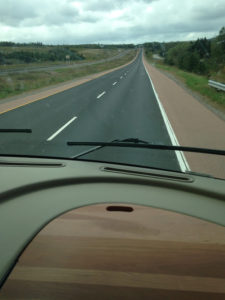 The trip from Halifax to Cape Breton Island is beautiful. One interesting feature, is that some of the paving uses the local red sandstone. In the photo to the left, the lanes have been repaved with regular surfacing, while the shoulders still have the original red surface (which shows through on the lanes wherever they are worn out.
The trip from Halifax to Cape Breton Island is beautiful. One interesting feature, is that some of the paving uses the local red sandstone. In the photo to the left, the lanes have been repaved with regular surfacing, while the shoulders still have the original red surface (which shows through on the lanes wherever they are worn out.
As we approached the Canso Strait, glimpses of the ocean added to the scenic views, and the Appalachian Mountains of Cape Breton Island begin to be seen.
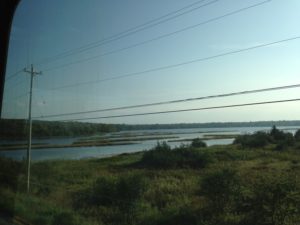
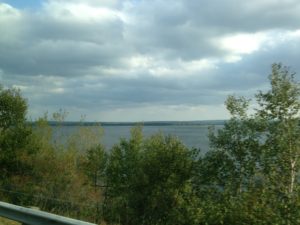
Cape Breton Island is separated from the mainland by only a very narrow strait, now spanned by a causeway and swing bridge. Despite this, a few mainland plant and animal species are not found on the Island. Once on the Island, the views are even better.
We camped in Baddeck (pronounced B’dek) which is on the Bras D’Or Lake. Our plan was to use this as our home base for a driving trip on the Cabot Trail.
Our first full day in Baddeck came with some rain and a persistent “Scotch mist”, as my family used to call it – something that is wetter than fog, but not quite rain. It was not weather for viewing the scenery. However, one thing on our agenda was to go to the Alexander Graham Bell Museum in Baddeck, so this created the opportunity.
Alexander Graham Bell was born in Scotland. However, after two of his brothers died of tuberculosis and he became ill, his parents moved the family to Brantford Ontario (my birthplace). He was already in his twenties at this point, with a few minor inventions to his credit. His history can be read on Wikipedia.
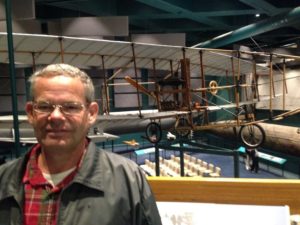 The salient fact for Baddeck is that although his main residence was in Cambridge MA, Bell used some of the proceeds from the Bell Telephone Company to build a large summer residence in Baddeck. While in Baddeck, with funding provided by his wife Mabel (a very interesting character in her own right) he worked with a number of aeronautics pioneers including Glenn Curtiss to design and build both tetrahedral kites (which Bell thought would better for powered flight than airplanes) and airplanes. Although the Wright Brothers had already demonstrated powered flight before any of the Bell planes got into the air, Bell’s Aerial Experiment Association was group to create an airplane to fly a kilometer. The core of the Baddeck Museum Exhibit is about theisaccomplishment.
The salient fact for Baddeck is that although his main residence was in Cambridge MA, Bell used some of the proceeds from the Bell Telephone Company to build a large summer residence in Baddeck. While in Baddeck, with funding provided by his wife Mabel (a very interesting character in her own right) he worked with a number of aeronautics pioneers including Glenn Curtiss to design and build both tetrahedral kites (which Bell thought would better for powered flight than airplanes) and airplanes. Although the Wright Brothers had already demonstrated powered flight before any of the Bell planes got into the air, Bell’s Aerial Experiment Association was group to create an airplane to fly a kilometer. The core of the Baddeck Museum Exhibit is about theisaccomplishment.
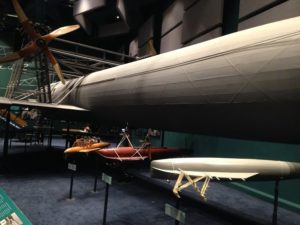 Another project which took place mainly at Baddeck towards the end of Bell’s life was the development of large hydrofoil boats. He and a young assistant Casey Baldwin built the first boat capable of going over 100 km/hr. Just as they were about to sign a large contract with the Canadian navy, WWI came to an end. They never proceeded with the project, although Baldwin continued to work on designs for smaller hydrofoil boats for recreational craft. The craft designed by Bell and Baldwin, the HD4, lay on the beach for years until it was recovered by the museum, where it is on display along with the full-scale replica above.
Another project which took place mainly at Baddeck towards the end of Bell’s life was the development of large hydrofoil boats. He and a young assistant Casey Baldwin built the first boat capable of going over 100 km/hr. Just as they were about to sign a large contract with the Canadian navy, WWI came to an end. They never proceeded with the project, although Baldwin continued to work on designs for smaller hydrofoil boats for recreational craft. The craft designed by Bell and Baldwin, the HD4, lay on the beach for years until it was recovered by the museum, where it is on display along with the full-scale replica above.
The museum also has displays about several other of Bell’s inventions including the graphophone (an improvement of Edison’s phonograph), a wireless phone (based on a large selenium chip) and other items.
Despite his wealth and scientific bent, 2 of Bell’s 4 children died in infancy. Remember that the death of his two brothers as young men were what spurred the family to move to Canada. I always keep life expectancy in mind when people bemoan the passing of the “good old days”.
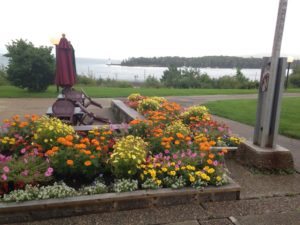 A section of the museum is devoted to the Bras D’Or Lake UNESCO Biosphere Reserve. Cape Breton “Island” is actually composed of several large islands that surround an estuary that is practically an inland sea. The largest body of water in the estuary is called Bras D’Or Lake, but the water is brackish so it is more properly a bay. “Bars D’Or” means Golden Arms, but the name might actually be a mispronounciation of Labrador (which is part of the Canadian province of Newfoundland). In any case, it is a hugely productive fish breeding ground and also harbours many bird species. The Museum also has a great view over the lake.
A section of the museum is devoted to the Bras D’Or Lake UNESCO Biosphere Reserve. Cape Breton “Island” is actually composed of several large islands that surround an estuary that is practically an inland sea. The largest body of water in the estuary is called Bras D’Or Lake, but the water is brackish so it is more properly a bay. “Bars D’Or” means Golden Arms, but the name might actually be a mispronounciation of Labrador (which is part of the Canadian province of Newfoundland). In any case, it is a hugely productive fish breeding ground and also harbours many bird species. The Museum also has a great view over the lake.
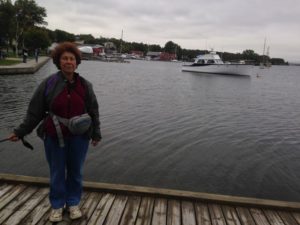
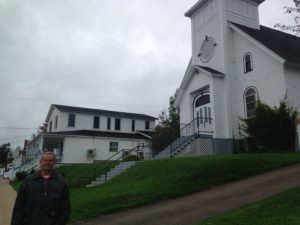 After we were done with the museum, we wandered through town, which has a nice waterfront on the lake and a few restaurants and souvenir shops. It also has a nightly ceilidh. We decided to have an early dinner at a local bakery and then stay for the ceilidh.
After we were done with the museum, we wandered through town, which has a nice waterfront on the lake and a few restaurants and souvenir shops. It also has a nightly ceilidh. We decided to have an early dinner at a local bakery and then stay for the ceilidh.
Recalling our disappointment in PEI, I headed off early to get tickets for the ceilidh. Lucky I did so, as several tour buses had already taken up most of the seats. The person selling the tickets turned out to be the fiddler and had taken a trip to central PA earlier this year, and we ended up chatting.
Michael Hall is a fairly big name in the local Celtic music scene. Despite this, most winters he has to go to Alberta to find work. The ceilidhs usually end on Sept. 25, but he had noticed that quite a few tour buses were still coming through, and asked the organizer if he could take it over and extend the season for another month. This was his first night organizing and he was gratified that the hall (which holds about 75) was full. His hope is to make enough money to stay in Cape Breton this winter. Given that there is the Celtic Colors Festival Oct. 9-15 that is already sold out for some events, I think he will succeed.
I thought perhaps the season has extended because the aging population is retiring and less tied to the school schedule. However, a museum curator speculated that the increase in visitors was due to the much-publicized invitation from Cape Breton to Americans who said that they would move to Canada if Trump were elected. This certainly brought Cape Breton to the attention of many Americans who had never heard of it. As well, Canadian National Parks are free this year to celebrate the 150th.
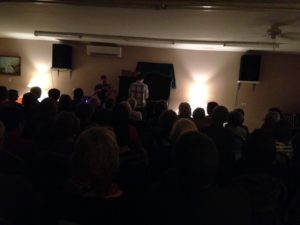 In any case, the ceilidh consisted of Michael on fiddle and Rob Deveaux on keyboard. Michael explained the origins of the music, and noted that many of the tunes do not have names. As well, the fiddler strings together medleys and chooses the key, while the pianist is forced to improvise and try to keep up. Michael also explained the difference between jigs, reels, Spathpey reels and waltzes, which definitely helped me follow the music. The music was great!
In any case, the ceilidh consisted of Michael on fiddle and Rob Deveaux on keyboard. Michael explained the origins of the music, and noted that many of the tunes do not have names. As well, the fiddler strings together medleys and chooses the key, while the pianist is forced to improvise and try to keep up. Michael also explained the difference between jigs, reels, Spathpey reels and waltzes, which definitely helped me follow the music. The music was great!
Besides the music, Mike and Rob were quite entertaining. At one point, they asked the audience where everyone was from. When one woman said she was from New Zealand, Rob noted that there was a legend that a ship had left Baddeck to take settlers to NZ. The woman said that her great grandmother had been on that ship, and that she was visiting the ancestral home. To which Rob noted that her ancestral home had belonged to his Acadian ancestors before it belonged to her British ones. His ancestors had been expelled from Nova Scotia to France but their descendents returned to Cape Breton a century later.
They also told us how they learned the music and the role it had played in their childhood. Mike made the point that the music had survived due to isolation and poverty. The same could be said of bluegrass.
We went to bed to the sound of thunder and the ping of rain on the RV, and woke up to the same. Although the thunder subsided, the rain continued the entire day. We stayed in the RV and worked. I also got the blog almost up-to-date. This blog takes longer to write than I expected (and perhaps I am also getting more long-winded).
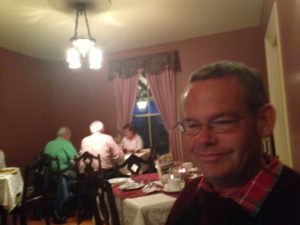
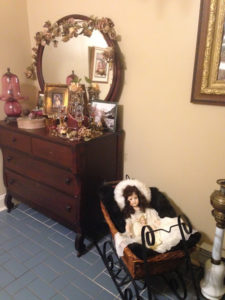
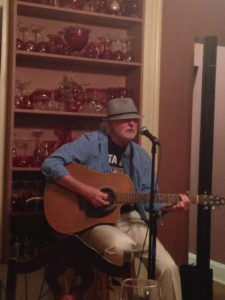 For dinner we tried to go to a nearby hotel with a great view. With several large tour buses already there, the wait was long. Instead, we went to the Lynwood Inn across the road from St. Michael’s Parish Hall where the ceilidh was held. The ambience was better than the food, but they also had a folk singer who entertained us with some 60s folk and as some Cape Breton traditional folk songs. I have been curious about a local song writer, Rita McNeil, who was quite famous in Canada in the 80s and 90s. By then I was living outside the country and so I had not heard her music. He graciously agreed to sing one of her numbers, which I enjoyed.
For dinner we tried to go to a nearby hotel with a great view. With several large tour buses already there, the wait was long. Instead, we went to the Lynwood Inn across the road from St. Michael’s Parish Hall where the ceilidh was held. The ambience was better than the food, but they also had a folk singer who entertained us with some 60s folk and as some Cape Breton traditional folk songs. I have been curious about a local song writer, Rita McNeil, who was quite famous in Canada in the 80s and 90s. By then I was living outside the country and so I had not heard her music. He graciously agreed to sing one of her numbers, which I enjoyed.
The next day dawned cloudy but rain-free. Rumple and I discovered that the RV park has a nature trail that follows the Baddeck River. After all the rain, it was like taking a walk in the creek, but it was pretty.
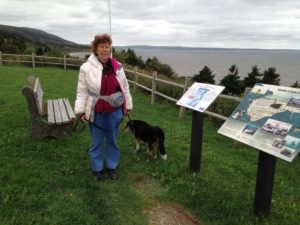
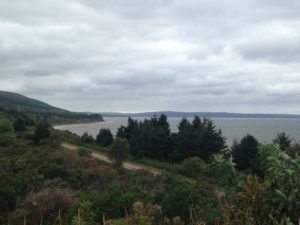 We decided to head back to the Canso bridge and then do half of the “Ceilidh Trail” before joining up with the Cabot Trail. The Ceilidh Trail follows the southern coast of the Gulf of St. Lawrence, but the water can only be seen at a few viewpoints. There is a RailTrail parallel to the road, which runs about 100 km from the Port Hastings to Inverness. I liked the bicycle rack below appropriately looking like a musical note.
We decided to head back to the Canso bridge and then do half of the “Ceilidh Trail” before joining up with the Cabot Trail. The Ceilidh Trail follows the southern coast of the Gulf of St. Lawrence, but the water can only be seen at a few viewpoints. There is a RailTrail parallel to the road, which runs about 100 km from the Port Hastings to Inverness. I liked the bicycle rack below appropriately looking like a musical note.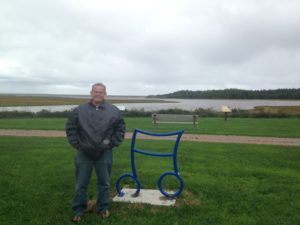
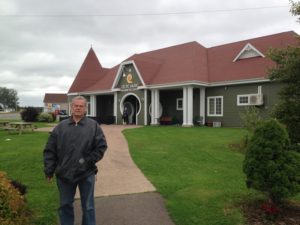
A major attraction accessible by road or bicycle path is the Celtic Music Interpretive Centre, a non-profit devoted to preserving and advancing Celtic music and the Gaelic language. In particular, they have free live music daily from 11:30 – 3:00. The music is good, and they serve lunch in their restaurant. We stopped there for a couple of hours to hear Chrissy Crowley accompanied by Allan Dewar on the piano. they are very good. 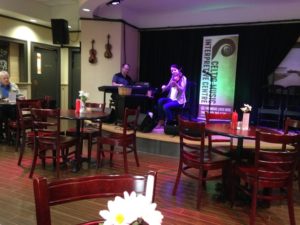 During a break we overheard her talking about how Michael Hall had inspired her to take up fiddle. Cape Breton is a small musical community.
During a break we overheard her talking about how Michael Hall had inspired her to take up fiddle. Cape Breton is a small musical community.
Unfortunately, the relatively good weather that we had in Baddeck did not follow us to the St. Lawrence coast. Looking at the weather radar, a line of clouds was hugging the coast. All of the rest of Cape Breton seemed to be enjoying a lovely day, but we had rain, fog and generally bad weather.
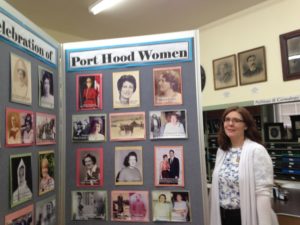 We decided to make a stop at the Chestico History Museum just outside Port Hood. This is a very small museum, with a lot of good items, and a great curator, Joanne Watts. As we were the only visitors at the time (although she said their had been a constant stream throughout the day) she walked us through the history of Port Hood and the exhibits.
We decided to make a stop at the Chestico History Museum just outside Port Hood. This is a very small museum, with a lot of good items, and a great curator, Joanne Watts. As we were the only visitors at the time (although she said their had been a constant stream throughout the day) she walked us through the history of Port Hood and the exhibits.
Contrary to what we had thought, Cape Breton used to have several thriving communities, particularly due to mining. Port Hood was an important coal center, and was importing miners from elsewhere. Unfortunately, the shafts ran under the bay, and once breached by the sea they flooded and so mining stopped. As the mines in the area began to run out, the train was no longer profitable and started running only between Sydney and the mainland. And so Port Hood has slowly declined.
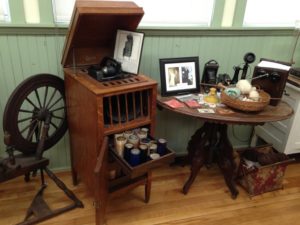 The museum profited enormously by purchasing the contents of a local home. The contents included a Bell graphophone including many wax cylinders, china wares, and kitchen items. As well, over the years they had put together several displays including a display on the impact of local women, and a display about local men serving in the world wars.
The museum profited enormously by purchasing the contents of a local home. The contents included a Bell graphophone including many wax cylinders, china wares, and kitchen items. As well, over the years they had put together several displays including a display on the impact of local women, and a display about local men serving in the world wars.
Many visitors to the museum are seeking geneology information. Joanne is an expert at doing geneology searches, assisted by lots of local information that was painstakingly uploaded by a local enthusiast. She got on the computer and showed us how all this works.
All in all, this small museum was a gem. We have often been pleasantly surprised by these small local museums, especially when a friendly and enthusiastic curator shows us around.
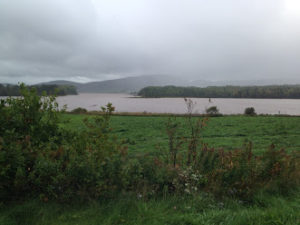 With no sign that the rain was coming to an end, we decided to return to the RV for the night via a short stretch of Cabot Trail. Fortunately, there is enough slack in the schedule right now that we can afford to stay an extra day in Cape Breton and wait for better weather.
With no sign that the rain was coming to an end, we decided to return to the RV for the night via a short stretch of Cabot Trail. Fortunately, there is enough slack in the schedule right now that we can afford to stay an extra day in Cape Breton and wait for better weather.
On Saturday morning, the weather in Baddeck was beautiful, but the St. Lawrence coast was still cloudy. We decided to set out none-the-less, and trust that the clouds would clear up as the day proceeded.
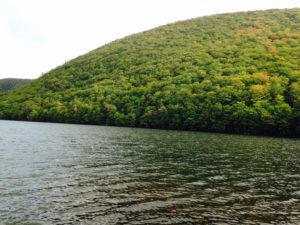 We retraced our route of the previous evening, making several stops to admire and photograph the mountains. The maple leaves are just beginning to turn, so there are touches of red and gold amidst the green and it is quite pretty. Most of the way towards the coast the weather alternated between rain, cloud and sun. However, when we got to the coast the rain stopped and we had fairly clear views over the mountains, valley and ocean.
We retraced our route of the previous evening, making several stops to admire and photograph the mountains. The maple leaves are just beginning to turn, so there are touches of red and gold amidst the green and it is quite pretty. Most of the way towards the coast the weather alternated between rain, cloud and sun. However, when we got to the coast the rain stopped and we had fairly clear views over the mountains, valley and ocean.
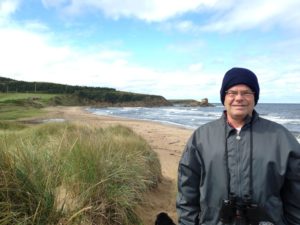 The southwest part of the Cabot Trail runs near the coast and is relatively flat. We decided not to visit the interesting looking puppet factory below, which makes mannequins for an Acadian festival Mi-Careme.
The southwest part of the Cabot Trail runs near the coast and is relatively flat. We decided not to visit the interesting looking puppet factory below, which makes mannequins for an Acadian festival Mi-Careme.
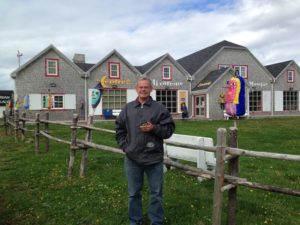
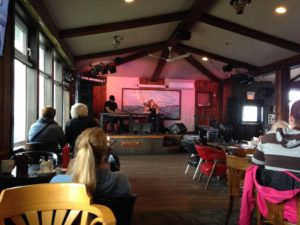
We stopped for lunch in the main town, Cheticamp. The Doryman’s Inn has fiddling daily from 2 – 6. We got there at 1:00 for lunch, but decided to stay until 3 to listen to the music. In the interim, we were able to watch grey seals fishing in the Gulf right outside our window.
The musicians were 2 members of Chrissy Crowley’s band, fiddler Rachel Davis and pianist Jason Roach. They played with unbelievable energy, doing very long sets with so much footwork that they were practically stepdancing. The floor was vibrating like a drum. It was hard to tear ourselves away.
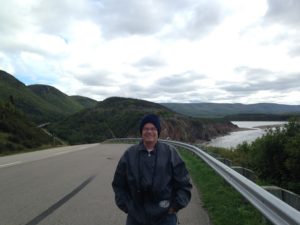
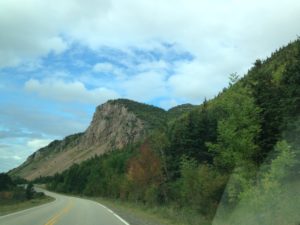 Just north of Cheticamp, the road starts climbing steeply into Cape Breton National Park. There were lots of beautiful vistas, many of which had convenient stopping points. Because of our frequent stops, we did not reach the summit until almost 5:00. There is a popular hike there, called Skyline trail. It was already pretty late, the wind had picked up and the temperature dropped. As well, Chuck wanted to tune in to the Penn State football game. We decided to continue on to the next town and return in the morning.
Just north of Cheticamp, the road starts climbing steeply into Cape Breton National Park. There were lots of beautiful vistas, many of which had convenient stopping points. Because of our frequent stops, we did not reach the summit until almost 5:00. There is a popular hike there, called Skyline trail. It was already pretty late, the wind had picked up and the temperature dropped. As well, Chuck wanted to tune in to the Penn State football game. We decided to continue on to the next town and return in the morning.
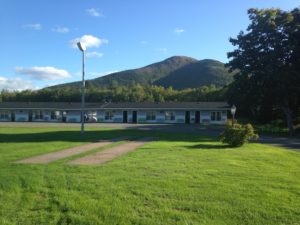 The road descends steeply into the town of Pleasant Bay. We stayed at a small cottage at the appropriately named Mountain View Inn. The restaurant attached to the motel has a nice dinner. And best of all, they had fiddle and guitar music in the restaurant this evening.
The road descends steeply into the town of Pleasant Bay. We stayed at a small cottage at the appropriately named Mountain View Inn. The restaurant attached to the motel has a nice dinner. And best of all, they had fiddle and guitar music in the restaurant this evening. 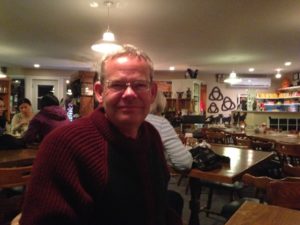 The fiddler was Christine Shaw – we did not get the name of the accompanist.
The fiddler was Christine Shaw – we did not get the name of the accompanist.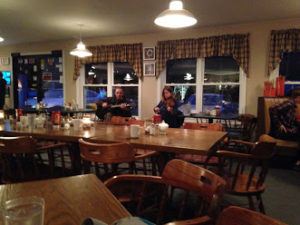
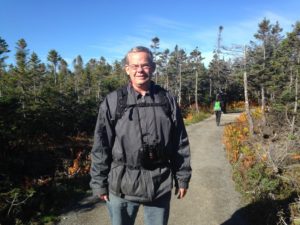 In the morning we headed back up the mountain to the Skyline Trail. This is a popular and well-maintained trail along the mountain top, with scenic views over the ocean and many interpretive signs. While it is a very nice hike, especially with the beautiful weather,
In the morning we headed back up the mountain to the Skyline Trail. This is a popular and well-maintained trail along the mountain top, with scenic views over the ocean and many interpretive signs. While it is a very nice hike, especially with the beautiful weather,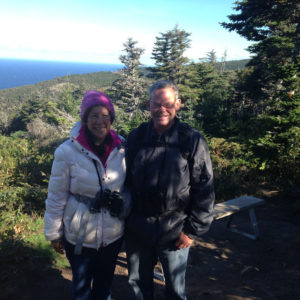 the views were very similar to those from the many roadside viewpoints.
the views were very similar to those from the many roadside viewpoints.
One of the things we learned from the interpretive signs was the story of moose on Cape Breton. By 1900, over-hunting had driven the moose to extinction. They were re-introduced in 1940 and were holding their own. However, in 1970, a natural infestation of spruce bud worm killed off large sections of the spruce forest.  The natural progression is for birch to colonize and then for the spruce to take over again. However, moose love birch seedlings. There was an explosion of the moose population to the extent that the birch could not get established. Instead, the areas turned into upland meadows that were perfect for the moose, leading to a new equilibrium.
The natural progression is for birch to colonize and then for the spruce to take over again. However, moose love birch seedlings. There was an explosion of the moose population to the extent that the birch could not get established. Instead, the areas turned into upland meadows that were perfect for the moose, leading to a new equilibrium. 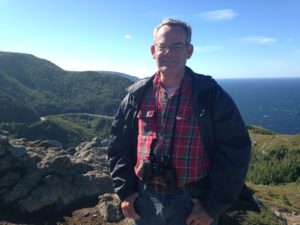 Now Parks Canada is trying moose exclusion areas to see if the old forest progression will take over.
Now Parks Canada is trying moose exclusion areas to see if the old forest progression will take over.
That is the part from the interpretive signs. Chuck read in a local newspaper that were was going to be a meeting to determine if there should be a moose cull, given the overpopulation. 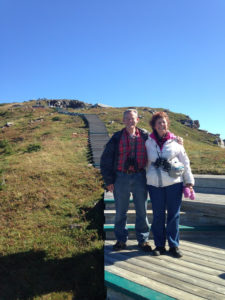
We also saw a sign protesting the moose cull, stating that almost half a million dollars had been spent in previous years to kill 37 moose. At one of the vistas, we met two moose hunters. We learned that about 30,000 people apply annually for 300 moose hunting licenses which are allocated by lottery (and these guys had been the lucky winners after 17 years of trying). They felt that the moose were sparse in some areas and plentiful in others, and that the need for culling was overstated. They also thought that Baddeck was one of the places where they are plentiful. Back in Baddeck for the evening, someone told us that the moose move off the mountains towards the coast during hunting season (which starts tomorrow) but that in any case she had seen a moose swimming in Baddeck Harbour today. We still have not seen a moose. But the hunters told us that moose are more plentiful in New Brunswick, our next stop, so there is still hope!
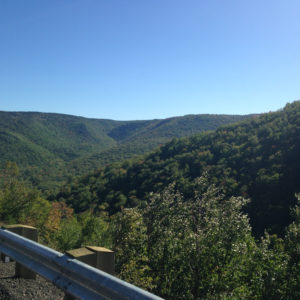
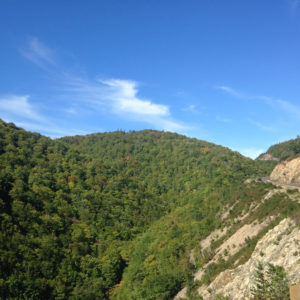 Another thing we learned on this trip is that the Atlantic Provinces have their own version of the Great Rift Valley, called the Aspy Fault. It can be seen in these photos as a very long, very wide rift in the mountains (which, incidentally, are part of the Appalachians).
Another thing we learned on this trip is that the Atlantic Provinces have their own version of the Great Rift Valley, called the Aspy Fault. It can be seen in these photos as a very long, very wide rift in the mountains (which, incidentally, are part of the Appalachians).
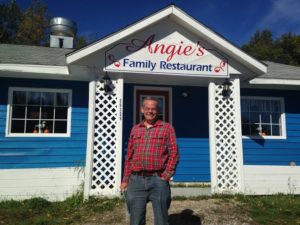
After completing the Skyline Trail, we meandered along the Cabot Trail, stopping for lunch at Angie’s – probably the best place we have eaten in Cape Breton.
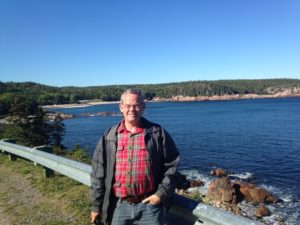 We stopped at a lot of beautiful vista points, and clambered over rocky outcroppings. Rumple was occasionally baffled about how to traverse the many crevasses and little pools.
We stopped at a lot of beautiful vista points, and clambered over rocky outcroppings. Rumple was occasionally baffled about how to traverse the many crevasses and little pools.
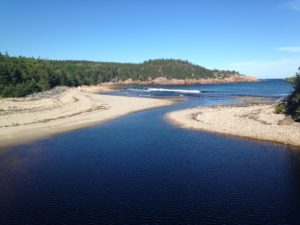
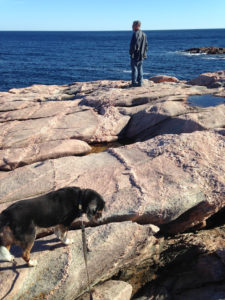
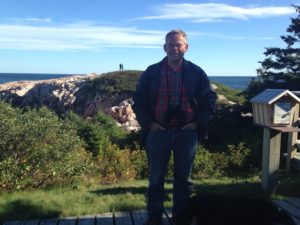
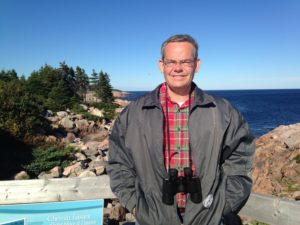
 We
We 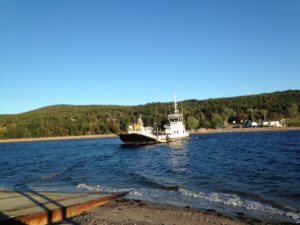
Towards the end of the trail, we veered off so that we could take the car ferry to Englishtown. This cuts out a bit of driving, but the main reason to take the ferry was for the view of St. Ann’s Harbor.
To finish off our trip, we decided to go to Baddeck for Chinese food and then back to the St. Michael’s Parish Hall for the nightly ceilidh. 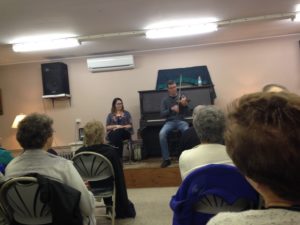 This time it was being run by Robert, who was also the accompanist, and the fiddler was Haley DeFort, who is “almost 21 and has been playing fiddle for 17 years”. Haley does not come from a musical family, but someone gave her a fiddle for her 4th birthday and the rest is history. The audience was pretty lively, and Haley ended up demonstrating step dancing with Robert playing fiddle, as well as responding to a request to do a vocal number. At that, Robert was also asked to do a vocal number, and sang an old French tune, accompanying himself on the fiddle. Not content with that, the audience also insisted on a piano solo – he managed to dredge something up that he had known 20 years ago, and acquitted himself well. Of course, they also did some Cape Breton fiddle music. All in all, it was a fun evening that made for a very nice ending to this part of our trip.
This time it was being run by Robert, who was also the accompanist, and the fiddler was Haley DeFort, who is “almost 21 and has been playing fiddle for 17 years”. Haley does not come from a musical family, but someone gave her a fiddle for her 4th birthday and the rest is history. The audience was pretty lively, and Haley ended up demonstrating step dancing with Robert playing fiddle, as well as responding to a request to do a vocal number. At that, Robert was also asked to do a vocal number, and sang an old French tune, accompanying himself on the fiddle. Not content with that, the audience also insisted on a piano solo – he managed to dredge something up that he had known 20 years ago, and acquitted himself well. Of course, they also did some Cape Breton fiddle music. All in all, it was a fun evening that made for a very nice ending to this part of our trip.
Cape Breton is going onto my “best of trip” list. One thing I would like to do is to be here for the Celtic Colours Festival, which occurs later in October and closes down the tourist season. Not only is there a lot of great music and dancing – the trees which are beginning to turn will be in full color (at least this year).
